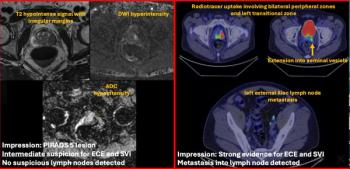
Report from SIR: Cryoablation freezes prostate cancer treatment complications
Focal cryoablation can kill malignant prostate tissue without affecting the urinary system or a man’s sexual potency, according to a study presented at the Society of Interventional Radiology meeting.
Focal cryoablation can kill malignant prostate tissue without affecting the urinary system or a man's sexual potency, according to a study presented at the Society of Interventional Radiology meeting.
Surgery and radiotherapy have shown effectiveness in combating prostate cancer. They treat the whole gland, however, potentially leading to sexual dysfunction and urinary incontinence.
Focal cryoablation, also known as the "male lumpectomy," targets and destroys only malignant tissue, while preserving healthy tissue in and around the prostate, said principal investigator Dr. Gary Onik, director of surgical imaging at the Center for Surgical Advancement at Florida Hospital in Celebration.
Early findings show that focal cryoablation outclasses standard treatment strategies for cancer control, while reducing the risk of complications. Most prostate cancer patients are potential candidates for the procedure, unlike brachytherapy, which is largely confined to low-risk individuals, Onik said.
To date, Onik and colleagues have treated 60 patients using the technique. Preliminary results for 42 patients who have been followed during eight years show that 95% have had stable prostate-specific antigen tests, with no sign of recurrence. Of 32 patients who were potent prior to the procedure, 78% (25) remain potent versus the average 30% with surgery and 50% with radiation therapy. There are no reports of urinary incontinence postcryoablation.
For many patients, incontinence bears far more importance than impotence. Cryoablation can limit this and other complications without compromising cancer control. If long-term studies confirm these findings, the technique has the potential to change the treatment paradigm, Onik said.
For more information from the Diagnostic Imaging archives:
Newsletter
Stay at the forefront of radiology with the Diagnostic Imaging newsletter, delivering the latest news, clinical insights, and imaging advancements for today’s radiologists.




























